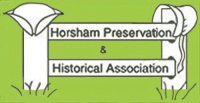Samuel Carpenter
- Editor:
- Kevin Winters
- Published:
- August 9 2018
- Updated:
- November 27, 2025
|
|
|
|
|
|

Public Domain – Carpenter & Carpenter
Samuel Carpenter, and his half-brothers Joshua and Abraham, came from Barbadoes to William Penn’s new city of Philadelphia shortly after it was established in 1681. All were very well educated and had money from investments in Barbadoes. Samuel had spent 10 years there investing in sugar and would soon become one of the wealthiest men in Pennsylvania. He became an early investor in Pennsylvania, purchasing approximately 5,200 acres northwest of the city from William Penn. 4,200 acres of this plot are now part of Horsham Township, Pennsylvania. Horsham was established as a municipal entity by a vote of the people in 1717 and apparently named after Carpenter’s birthplace in Sussex, England, but this was not known until much later.
The question of where the Carpenters had originally come from before Barbadoes had long been a mystery since they left no mention of their birthplace. (Carpenter & Carpenter- p1)
Horsham, Sussex to Horsham, Pennsylvania
“Lately [editor – this would be before 1912 when this quote was published], a statement was found, in the annals of the city (Philadelphia), to the effect that the township of Horsham, to the north of Philadelphia, was in the first place principally owned by Samuel Carpenter, and that when the settlers thereon went to Samuel Carpenter, and asked him what name he would like for the township, he (asked) to call it ‘Horsham.’ This story coming to light made some who were interested think that probably Samuel Carpenter had some connection with Horsham; and soon after, in September, 1900, while making some investigations in England, Mr. Thomas Allen Glenn discovered evidence, in the register of the Parish Church of St. Mary’s at Horsham, to show that Samuel Carpenter, the first of his name in Philadelphia, was born there, and probably lived there until after his father’s death in 1671, when he left with his share of the patrimony to seek his fortunes in the Barbadoes. The register shows that Samuel Carpenter was bom November 4, 1649, and christened December 20, 1649, and that he was the son of John Carpenter by Sarah his wife.”
The first mention of the Township name was on “11 mo. 15, 1717 he (Peter Davis) married Rebecca Michener ‘at the meeting hous at horsom,’ the first recorded wedding at that meeting.” (Smith p21) and in Hannah Carpenter’s deed to Horsham Meeting in 1718 where she describes the township as “called or to be called Horsham”. Smith also cites a deed from 1748 for land near Prospectville stating that Carpenter called his tract Horseham. [editor: this was a small village that was centered at Limekiln Pike and Horsham Roads in the northwest part of the township and part of Carpenter’s land. The Prospectville Post Office was absorbed by the Ambler Post Office sometime in the 2000s so the name of Prospectville is no longer in use] (Smith p3)
Society of Friends
The Carpenters’ father died in Horsham, Sussex on August 9, 1671. Samuel must have left for Barbadoes shortly after since he was fined there in 1673 and again in 1683 for failing to furnish men in arms. Making war and providing soldiers is against Quaker beliefs and Samuel apparently had previously converted. Quakerism was present in Horsham, Sussex as early as 1655. Samuel was too young at that point to convert but apparently did so before leaving England. There is no record of anyone else in the family joining the Friends. (Carpenter & Carpenter p5)
The rest of Carpenter’s family, including two half-brothers, who later became successful in Philadelphia, remained faithful to the Church of England (Joshua was prominent as one of the founders of Christ Church, Philadelphia).(Carpenter & Carpenter p5).
Barbadoes
In 1673, Samuel joined a colony of Quakers on the island of Barbados, where he stayed about ten or eleven years. While there, he was fined in 1673 “one thousand one hundred and ten pounds of sugar” for not appearing or not sending men in arms to render military service. This was recorded in “A Collection of the Sufferings of the People called Quakers for the Testimony of a Good Conscience,” by Joseph Besse, published in 1753. (Carpenter & Carpenter p7) The Quakers were against the use of slaves on the sugar plantations of Barbados and, in 1676, were also prohibited from preaching Christianity to the slaves. Samuel was once again fined in 1683 for not sending men with arms for military service. He and a Henry Wheately were fined “6,673” pounds of sugar. In consideration of leaving Barbados, the fine was suspended. (Carpenter & Carpenter p7)
William Penn
One of the more prominent Quakers was William Penn who, against the wishes of his father Admiral Sir William Penn, announced himself as a Quaker in 1667 at the age of 22. (Fantel p69 ) Penn was persecuted and jailed several times – the first time in Cork, Ireland where he had converted and was then thrown out of the house by the Admiral (Buckley,Eila p87 ). He reconciled with his father before the elder Penn’s death in 1670. In 1677 he was part of a group that was granted land in Western New Jersey. Penn did not visit this location but drafted a charter of liberties for the settlement. He guaranteed free and fair trial by jury, freedom of religion, freedom from unjust imprisonment and free elections. (Independence Hall)
Pennsylvania
In 1681, with the support of the Duke of York, Penn convinced the King to grant him what is now known as Pennsylvania in payment of a £16,000 debt owed by the King to the Admiral. This land had actually belonged to the Duke. Charles was glad to be rid of the debt and probably of Penn and his Quakers. In 1682, Penn drew up his “Framework of Government” for the Pennsylvania Colony, which included the novel idea of freedom of worship. Penn advertised this throughout Europe and the West Indies to entice Quakers and others to his new colony. (National Park Service (NPS) – no date ) This grant for land west and south of New Jersey, an area encompassing 45,000 miles, made Penn the largest non-royal landowner. William named this land Sylvania but Charles changed it to Pennsylvania or Penn’s Woods in honor of Penn’s father. Bucks County, just across the road from Horsham in Pennsylvania, was named after Buckinghamshire where Penn and many of the first settlers were from. (Carpenter & Carpenter)

A portrait of William Penn after receiving a royal deed from King Charles II
BY: Jean Leon Gerome Ferris – This image is available from the United States Library of Congress’s Prints and Photographs division under the digital ID cph.3g07157. Public Domain
Carpenter Travels to Philadelphia
Carpenter, along with many other Quakers, emigrated to the new colony of Pennsylvania in 1683 to escape the persecution which had become common across the West Indies. Penn had been granted The Charter of Pennsylvania by Charles II to William on January’ 5, 1681, so the Carpenters were very early members of the colony.
Samuel, Joshua, and Abraham Carpenter came to the Province of Pennsylvania with money. The brothers, especially Samuel and Joshua, were well-educated men, of excellent ability and judgment, and soon made their mark in the colony. (Carpenter & Carpenter p5 ) Samuel arrived in Philadelphia around July 10, 1683, quite wealthy from the sale of his holdings in Barbados and his inheritance. He had made a number of investments in plantations, mines, mills, wharves and other property. On December 12, 1684, he married Hannah Hardiman, who had emigrated from “Haverford West Meeting in Wales the 2d of the 6th Month 1683”. The original certificate written on parchment is in the possession of the Historical Society of Pennsylvania. It is the earliest marriage certificate in Pennsylvania now known to be in existence. (Carpenter & Carpenter p8 )
Pirates, Lousy Rations and Living in Caves
Francis Daniel Pastorius, a German traveler sailing from Deal, described being chased by pirates and having little to eat on his 2 month journey in 1683, landing a month after Carpenter:
“Philadelphia then consisted of three or four little cottages, all the residue being only woods, underwood and timber, in which Pastorius says he several times lost himself in travelling from the water-side to the house of Cornelius Bom, the baker, which stood near the comer of Third and Chestnut Streets. All kinds of temporary expedients had to be resorted to. Pastorius and his companions were obliged to occupy caves in the river bank until the lands assigned to them could be surveyed and houses built for their accommodations.”
Germantown
Pastorius represented the Frankfort Land Company and acted as agent to conduct a colony of Dutch and German Mennonites and Quakers to the new colony. The Company purchased 25,000 acres and Pastorius laid out the town of Germantown. He became a life-long friend of Samuel Carpenter.(Carpenter & Carpenter p19 )
Carpenter’s Mark on Philadelphia
Samuel Carpenter came to Philadelphia a rather wealthy man from his investments in Barbadoes and continued to expand his fortune with additional investments in his new home. A sample below:
Carpenter’s Wharf
Carpenter bought a lot extending from King Street (renamed Water Street during the Revolution and which is now under Interstate Highway 95 (Kyriakodis )) to Front Street and on to Second Street in 1683. This lot extends to Ton Alley (later Tun but also now buried under Interstate Highway 95) . William Penn, in a letter written in 1683 describing some of the facts of chief interest in Philadelphia, says, “There is a fair key of about 300 feet square a little above Walnut Street built by Samuel Carpenter to which a ship of five hundred tons may lay her broad side.” Gabriel Thomas, who came from England in the ship “John and Sarah” in 1681, in his account printed in 1698 says, “There is also a very convenient Wharf called Carpenter’s Wharf which hath a fine necessary Crane belonging to it with suitable granaries and store houses.(Carpenter & Carpenter p13 )
Although Penn was appreciative of this wharf, Carpenter and others “presented Penn’s agents with a petition that sought “full and free liberty to build as high as they please above the top of the [bank of the Delaware], which they were not to do by a clause in the said rexive [recited] former Patents.” which was approved on April 26, 1690. When Penn returned to the city in 1699 he was not happy and in 1703 issued the directive: “I will have no more bank lots disposed of, nor keys [docks] yet made into the river, without my special and fresh leave, for reasons justifiable.” (Kyriakodis )
Carpenter’s Wharf was expanded and used for over a century.
Slate Roof House
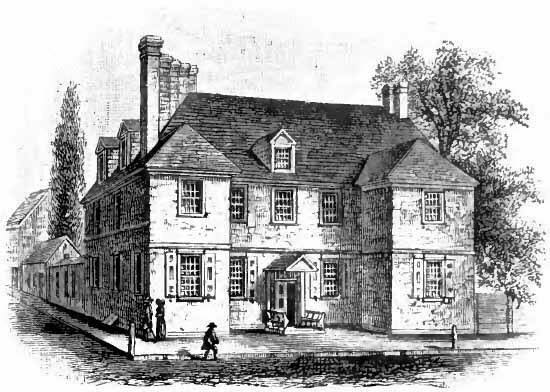
2nd Street, Philadelphia, PA USA – date and artist unknown
(from Slate Roof House – American Aristocracy)
Samuel Carpenter later built the historic “Slate Roof House,” at No.16 Second Street north of Walnut overlooking the Delaware River in 1687. It was built of brick in the Jacobean style, and was notable for its large size and slate roof. William Penn, from 1699-1701, was only the 1st of many notables to call the house home. James Logan, the secretary of the Proprietary after Penn returned to England stayed here from 1701-1704 and John Adams, John Hancock, and others from the Continental Congress also lived here at various times. The Slate Roof House was razed in 1867. “Welcome Park” was built on its site in 1982. (Wikipedia )
Tun Tavern
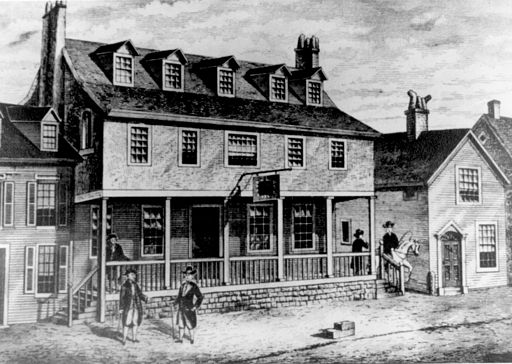
date and artist unknown (from National Archives) Public Domain
Carpenter and his brother Joshua, in 1693, also established the Tun Tavern (also called the Globe Tavern) in Philadelphia. “Tun” is old english for barrel or keg of beer. The Tun Tavern is famous for holding the first recruitment drive during the Revolutionary War for what would become the United States Marine Corp (USMC) on November 10, 1775, and for being the “birthplace of Masonic teachings in America” with the first meetings of the St John’s #1 Lodge in 1732. (Tun Tavern )
Other organizations that trace their origins to The Tun include: “Society of St George” (1772), “St Andrews Society” (1747), “The Friendly Sons and Daughters of St Patrick” (1771) and the United States Navy (1775) (The Tun )
“Originally opened in 1693 as what would today be called a Micro-brewery, it was one of the first taverns erected in the new settlement of Philadelphia. Originally built by Master Brewer, Joshua Carpenter, with the help of his brother Samuel Carpenter, The Tun had a reputation for the finest beer in Philadelphia. The demand for Joshua Carpenter’s beer was so strong that after operating The Tun for only about three months he decided to lease the tavern to someone else so that he could focus on his passion – crafting the finest beer and ale. It was apparently a good decision, as Joshua Carpenter was considered one of the wealthiest men in Philadelphia at the time of his death in 1722. Between them the Carpenter brothers owned four taverns and/or “coffee houses” (coffee and tea on the first floor, beer and spirits on the second). Joshua Carpenter’s businesses were so successful that he was one of the principal founders and financers of Christ Church in Philadelphia; a structure that still stands to this day.”
The tavern was renamed “Peggy Mullan’s Red Hot Beef Steak Club at Tun Tavern” in the 1740s and burned down in 1781, near the end of the American Revolution. This site, like others mentioned here, is now under Interstate 95 which runs along the waterfront in Philadelphia. (Tun Tavern )
Other Investments
In addition to mentioned above, Samuel Carpenter had a number of other ventures:
- An estate with saw and grist mills which included most of the present town of Bristol, PA
- Multiple lots in Philadelphia
- A grist mill in Chester co-owned with William Penn and Caleb Pusey
- Bakery and Ten Warehouses
- One half of a mill at Darby
- The Sepviva plantation, containing 380 acres, part of Fair Hill, in the County of Philadelphia.
- One thousand acres in Piles Grove Township, Salem County, New Jersey.
- Fifty acres lying between the lands of William Cooper and of John Kaighn in the City of Camden.
- Six hundred acres on Timber Creek in New Jersey, constituting part of the Howell estate of “Fancy Hill.”
- Eleven hundred acres situated in Elsinborough near the site of the old Swede Fort in Salem County, New Jersey, and including the farm now or formerly owned by Clement Hall.
- Three-sixteenths of five thousand acres of land and a mine called Pickering’s mine.
- A coffee-house at the northeast corner of Front and Walnut Streets and scales.
- Five thousand acres of land lying on Poquessing Creek fifteen miles from Philadelphia in what is now Horsham Township
(Carpenter & Carpenter p17 )
Public Life
“From the time of his arrival in Pennsylvania, Samuel Carpenter was actively engaged not only in the multifarious transactions of his own private business, but also in the improvements of the town and in the affairs of government. Watson, in his Annals of Philadelphia, says, “The name of Samuel Carpenter is connected with everything of a public nature in the early annals of Philadelphia. I have seen his name at every turn in searching the old records. He was the Stephen Girard of his day for wealth, and the William Sansom in the improvements he made and the edifices he built.”
Samuel Carpenter served the new colony as Deputy Governor from 1694-1698. William Penn, as Proprietor, was the governor, but often left management of the colony to the deputy governor. He also served as Treasurer (1704–1710, 1711-1713), Member of the Assembly 1693–1694, 1696 and Member of the Assembly in Bucks County (1705). Carpenter also sat on what was probably the first Grand Jury in Pennsylvania which found Margaret Mattson and Yestro Henderickson guilty of having the common fame of a Witch but not Guilty in manner and form as she stands indicted. (Carpenter & Carpenter p13 )
Carpenter’s Land in Horsham Township
The new English colony on the Delaware became immediately popular in Europe, and attracted many men of wealth and distinction to these shores. [Editor: William Penn heavily promoted the colony throughout Europe] Much of their wealth was invested in land, because of their confidence in the successful future of the Colony, and Penn’s resident land commissioners made sales more rapidly than his surveyors were able to complete their surveys. As is usual when new lands are open to settlement, relatively few of the first land buyers intended to settle on their purchases. They were speculators, depending on a rapid influx of bona fide settlers to make their investments profitable.
Thus practically all the available land within 30-40 miles of Philadelphia passed into private ownership before the end of the year 1686, and was so plotted on Holme’s map. The district which later became known as Horsham Township had been allotted to four individuals: George Palmer, Joseph Fisher, Samuel Carpenter and Mary Blunston. A member of the family later settled on the Palmer tract; the other three purchasers lived elsewhere, and sold off their land as rapidly as opportunity offered.
Samuel Carpenter purchased 5,088 acres 15 miles northwest of Philadelphia, Approximately 4300 acres included all that part of Horsham Township lying east of Horsham Road from the Moreland Township Line to Chestnut Land. The remainder lay in Bucks County.The latter portion extended from the county line along Mud Lane to Street Road, northwest on Street Road for about a mile and a quarter , and back to the county line, an area of about 800 acres. (Smith p6)
Carpenter apparently purchased this tract shortly after his arrival from Barbadoes, for his warrant was dated Aug 4, 1684. However, it was not staked out until after the Palmer tract was surveyed on 2 mo, 14, 1685, and the deed was not executed until August 27, 1702 (A 4, p.40; E7, vol * p. 365; F1, p 97). Actual settlement did not begin until some years later; the first deed of subdivision was dated Feb, 13m 1709. Between that time and the date of his will, 2 mo. 6, 1714, he had disposed of some 1600 acres, and had contracted for the sale of still other portions of the tract. His will directed Hannah Carpenter, his widow and executrix, to complete these transactions. She closed out the last portion of the Horsham estate in 1719.(Smith p7)
Carpenter’s Horsham Land Confiscated
Carpenter’s estate was held liable for £2,000 that had been promised to the queen – in lieu of sending soldiers to fight against the French in Canada – in 1709. Carpenter, as treasurer of the colony, was held responsible for a gift that was voted on by the assembly to be given to Queen Anne c1711 in lieu of the colony sending troops to fight the Indians in what was known as Queen Anne’s War. The war was ending, though, and the amount was never sent.
“When, in Queen Anne’s time, the Assembly of the Quaker Province were induced to aid the expedition against Canada by voting two thousand pounds,professed to be not for the war, but “for the Queen’s use,”it was provided that the Governor’s receipt should be the voucher for the Treasurer. The expedition failing, nearly the whole amount remained a charge against Samuel Carpenter, then Treasurer, until his death. On November 12, 1717, Lieutenant-Governor Keith asked the opinion of the Council whether he should not call upon the executors of the late Treasurer for the money or an account, and the Council agreed that he should. Subsequently a large sum was paid to him, and, as the equivalent of five hundred pounds, there were conveyed to him by deed of March 5, 1718, from Andrew Hamilton, who had just taken title from the executors, twelve hundred acres of land in Philadelphia County, bounded on the northeast by the line of Bucks County.”
To settle this debt, 1,200 acres, mostly in Horsham, was sold and somehow became the property of Deputy Governor Sir William Keith. Keith added 300 additional acres to the 1,200 he acquired from the Carpenter Estate to create his 1,500-acre Fountain Low plantation.
It was later acquired by his son-in-law, Dr. Thomas Graeme, who renamed it Graeme Park. Graeme Park still exists but has been reduced to 42 acres which is now owned by the state of Pennsylvania. The National Historic Landmark c1722, Keith House, is located here, and the restored c1721 Penrose-Strawbridge House is located several hundred yards away on part of the original estate that is now owned by Horsham Township.
Horsham Meeting
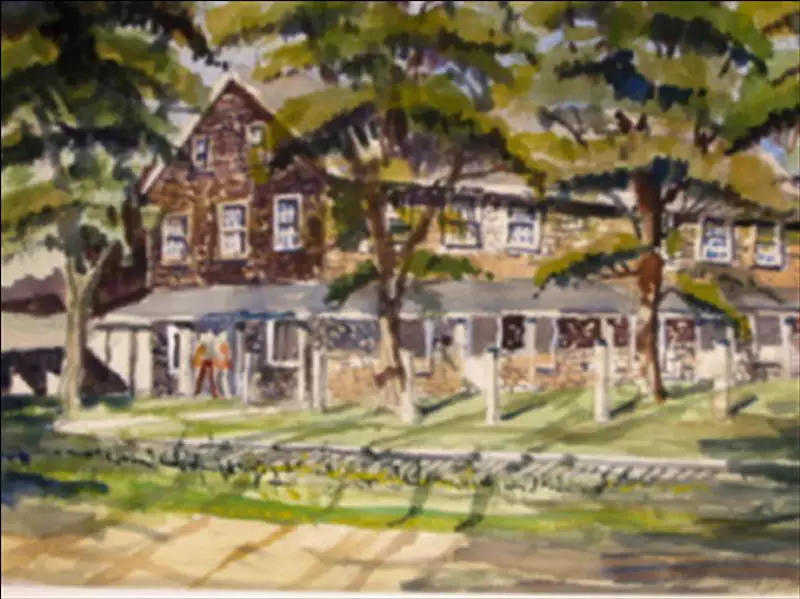
Carpenter’s Indenture
Samuel Carpenter’s purchase of 5,088 acres from Penn’s commissioners of property was finalized May 26, 1706, and although a portion extended into Bucks County, this land comprised over one-third of the area of the present township. It had a front on the Horsham road of four miles. Prospectville. Horshamville, Davis Grove, and Graeme Park, are located on it.(Bean )
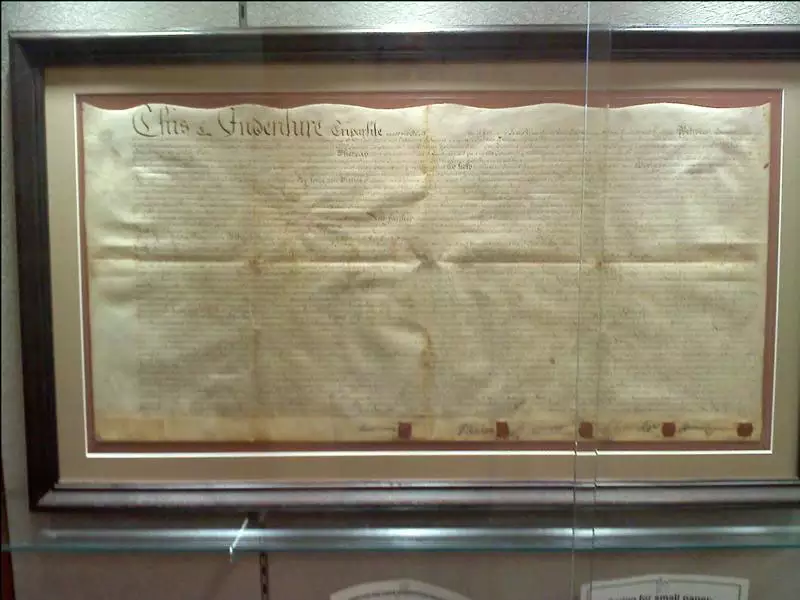
An indenture, defined by Dictionary.com, is “a deed or agreement executed in two or more copies with edges correspondingly indented as a means of identification.”
This indenture shows the indented edge along the top, and along the bottom the signatures and wax seals of each party. This is a rare find and a fascinating piece of local history. It has been displayed at the Horsham Library and at the Horsham Tricentennial Gala. It is currently on display at the Penrose-Strawbridge House.
Transcription
Transcription by Volunteer Emery Schoenberg
“This Indenture Tripartite made the Third __ day of February In the Year of our Lord One Thousand Seven Hundred and Eighteen Between Hannah Carpenter of the City of Philadelphia in the Province of Pennsilvania Widow Robin and Executrix of the Last Will and Testament of Samuel Carpenter late of the same place of the first part Samuel Carpenter of the City (one of the sons of of the second Samuel Carpenter Son). John Carpenter of the City (the other son of the Samuel Carpenter Son.) and William Fishbourn of the City Hannah his wife daughter of the Samuel Carpenter of the part Andrew __ Hamilton of the City Esq __ of the third part Whereas there is a certain Grant of Land situate part in the County of Philadelphia and part in the County of Bucks containing Five Thousand and Eighty Eight Acres Which of Land With the Appurtenance thereto belonging was Granted and Confirmed unto the Samuel Carpenter his and in and by a certain patent or instrument under the hands of Edward Shippen, Giffith Owen, Thomas Story and James Logan Pate Commissioners of property of William Penn proprietary and Governour in Chief of the province and proprietory Seal To hold to him the Samuel Carpenter his and forever Having therefore unto the proprietary his and the Yearly of one English Silver Shilling For every hundred Acres and so proportionably and by the patent bearing date the Twenty Sixth day of May Anno Doii One Thousand seven hundred and Six Recorded in the of _ Office of Philadelphia in Patent Book Appears By Force and Virtue of patent or by Force and Virtue of some other good Conveyance or in Law only had and exicuted by Samuel Carpenter in his Lifetime lawfully Siezed in the of of and in a certain parcel of Land hereinafter described (part of the Grant of Five Thousand and Eighty Eight Acres) Together with the Appurtenances and the Samuel Carpenter being so thereof seized made the Last Will and Testament in Writing bearing safe the Sixth day of the month called April Anno Doii One Thousand Seven Hundred and Fourteen And thereby (but alia) Devised in these words. That is to say, Also I nominate and Appoint my dear wife Hannah Carpenter Sole Executrix during her life And From and immediately after her decease my Children Samuel Carpenter John Carpenter William Fishbourn and Hannah his wife Executors of this my Last Will and Testament hereby Impowering and fully Authorizing my said wife and Sole Execut. my other Executors after her decease or any Two of them and the Survivor and Survivors of them and the Executors of the Survivor As well to Grant convey and all or any such and as are or shall be by me Sold but not Actually Conveyed in my lifetime to any person or persons whatsoever there and forever. As also to Grant Bargain Sell and Convey to any person or persons his her or forever All or any of my Lands and whatsoever or wheresoever situate lying and being not by me sold in my Lifetime. And Further amongst other things of the Testator willed in these words, that is to say, and in case of any Sale of any of my lands and Real Estate as aforsed. Seal and Deliver any Deed or Deeds Writing or Writings and requisate Solemnities, as in and by the Testament being thereunto had more …”
Samuel Carpenter
Carpenter was likely the wealthiest and most powerful person in the colony of Pennsylvania behind William Penn. He did suffer some setbacks from losses due to pirates, the war of 1703, and depreciation of his property, forcing him to sell some of his assets.
After his death, his estate was held liable for the funds that had been allocated in 1709 as a gift to Queen Anne to help finance an expedition against the French in Canada. The estate settled this issue with 1200 acres of land, much of what is now is Horsham, PA. This land was apparently sold to Andrew Hamilton who then conveyed it to Lt Governor Sir William Keith.
Samuel Carpenter died at the house of his son-in-law, William Fishbourn, at Sepviva plantation (380 acres are now part of “Fair Hill”) in Philadelphia on April 10, 1714, and is buried at at the Society of Friends (Quakers) Burial Ground at Fourth and Arch Streets in Philadelphia.
References
- Carpenter, Edward & Carpenter, Louis H (1912) Samuel Carpenter and His Descendants (Available at: https://archive.org/stream/samuelcarpenterh00carp/samuelcarpenterh00carp_djvu.txt Accessed 4/2/2016 and November 27, 2025 ), Philadelphia, Printed for private circulation by J. B. Lippincott company
- Smith, Charles Harper (1975) The Settlement of Horsham Township Trinity Press, Ambler, PA (HPHA Library)
- Hans Fantel (1974), William Penn: Apostle of Dissent, William Morrow & Co., New York, p. 6, ISBN 0-688-00310-9
- Buckley, Eila (1944) William Penn in Dublin Dublin Historical Record Vol VI No 3 June-August 1944 Available at: https://www.jstor.org/stable/30105469 (login required) Accessed:June 24,2025
- National Park Service – (no date) William Penn – Available at: https://www.nps.gov/people/william-penn.htm Accessed June 4, 2025
- Independence Hall Association copyright 1999-2025 Brief History of William Penn . Available at https://www.ushistory.org/penn/bio.htm Accessed May 30, 2025
- Kyriakodis, Harry Hidden City:The Street Under The Bank (March 12, 2012) Available at https://hiddencityphila.org/2012/03/the-street-under-the-bank/ AccessedL 11/27/2025
- American Aristocracy Slate Roof House (No Date) Available at: https://americanaristocracy.com/houses/slate-roof-house AccessedL 11/27/2025
- Wikipedia Slate Roof House (Last edited September 5, 2025) Available at: https://en.wikipedia.org/wiki/Slate_Roof_House AccessedL November 27, 2025
- Tun Tavern Historic Tun Tavern and the Marine Corps in Philadelphia (No Date) Available at: https://www.tuntavern.com/brewery-tours-2 Accessed Novermber 27, 2025
- The Tun A Rich History (No Date) Available at: https://thetun.org/history/ Accessed: November 27, 2025
- Charles P. Keith and William Keith “Sir William Keith” The Pennsylvania Magazine of History and Biography, Vol. 12, No. 1 (Apr., 1888) , pp.1-33 published by The Historical Society of Pennsylvania Stable URL www.jstor.org/stable/20083246
- Theodore W Bean, ed., History of Montgomery County (Philadelphia, PA Everts & Peck, 1884)
